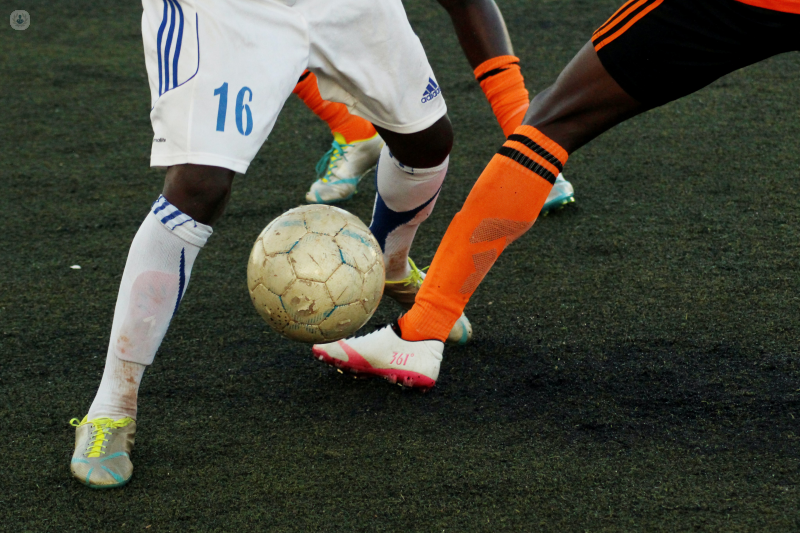Can sports injuries raise my risk osteoarthritis how prevent
Escrito por:Osteoarthritis is one of the most common types of arthritis that affect millions all over the world. For most people who exercise or play a sport regularly, there is no concern regarding their risk of developing osteoarthritis. However, certain sports can increase your chances of a joint injury which sometimes leads to the condition.
In this article, Mr Sunil Kumar, a leading consultant orthopaedic surgeon, explains what exactly osteoarthritis is, the type of sports that may put you at a higher risk and lists some effective osteoarthritis prevention strategies.

What exactly is osteoarthritis and why does it occur?
Osteoarthritis is the term used to describe the wearing away of the protective lubricating and cushioning articular cartilage - the shiny layer that covers the ends of the bones in the joint. Normal articular cartilage also acts like a “shock absorber”, and any wear, therefore, leads to loss of shock absorption capacity, which, in turn, predisposes to further wear.
A combination of factors play a role in the development of osteoarthritis, including wear and tear, sometimes provoked or exacerbated by injury and a genetic element, which subsequently leads to weakening and increasing risk and rate of wear. As the cartilage breaks down, the ends of the bones become roughened and as they rub together (as they would during movement), the friction causes inflammation, pain and eventually stiffness.
What are the risk factors for osteoarthritis?
Risk factors for developing osteoarthritis include:
- Age – with age there is a change in the proportion of water to protein within the articular cartilage. This change in ratios increases the vulnerability to injury and wear and tear.
- Obesity – this is particularly relevant to weight-bearing joints.
- Genetics – defects in genes responsible for making cartilage and bone make the joints more vulnerable.
- Gender – osteoarthritis is more common in women, particularly over the age of 55. Bleeding disorders – bleeding into joints from a relatively minor trauma, e.g. haemophilia, can degrade the articular cartilage.
- Hypermobility – “super flexible joints” (extra bendability) can also be predisposed to increased wear.
- Other forms of inflammatory conditions affecting joints such as gout and rheumatoid/psoriatic arthritis.
What are some early signs of osteoarthritis?
Osteoarthritis most commonly affects the hands, knees, hips, spine and big toes. Early symptoms include pain (after overuse or long periods of inactivity), tenderness, inflammation, stiffness and bony enlargement around joints which is initially caused by inflammation and eventually due to bony overgrowth.
How can I prevent osteoarthritis from developing in my joints?
These are some of the most effective osteoarthritis prevention strategies:
- Maintain a healthy BMI/weight with a healthy diet. This includes avoiding sugary and fried foods, cutting down on alcohol, red meat, dairy and cheese and refined carbohydrates.
- Be active. This involves regular gentle low impact, low resistance, range of motion exercises.
- Try to avoid periods of relative inactivity.
- Prevent injury to joints. If this occurs, early assessment and treatment are essential.
- Do not ignore pain and use mobility aids if necessary.
- Wear good footwear and avoid high-heel shoes.
Which types of sports are high-risk?
In general, all sports are ok. Good exercises include walking, cycling, swimming, tai chi, yoga and water aerobics.
Other forms of exercise which may lead to bone and joint injury would include repetitive, heavy load-bearing impact and pivoting activity. This would include sports like squash, basketball, football, skiing, road running, cycling outside, boxing and rugby.
Recently, there have been studies to show that texting excessively may also put children (aged 9 to 15) at an increased risk, and girls tend to be more vulnerable than boys. Mobile devices were not necessarily designed for children and can provoke developing bones, joints and tendons.
How can I avoid joint injuries?
By undertaking the prevention strategies mentioned above, joint injuries can be reduced by at least 50%. For those regularly undertaking high-impact sporting activity, in addition to the above, it is essential to warm up and warm down. Specific guidance is also available from international sporting bodies, such as FIFA. They have produced the FIFA 11+ warm-up guidance, which takes twenty minutes and has been shown to reduce football injuries by up to 50%.
If you are worried about any of the symptoms of osteoarthritis and would like to talk to a specialist, visit Mr Sunil Kumar’s Top Doctors profile and book an appointment to see him.


